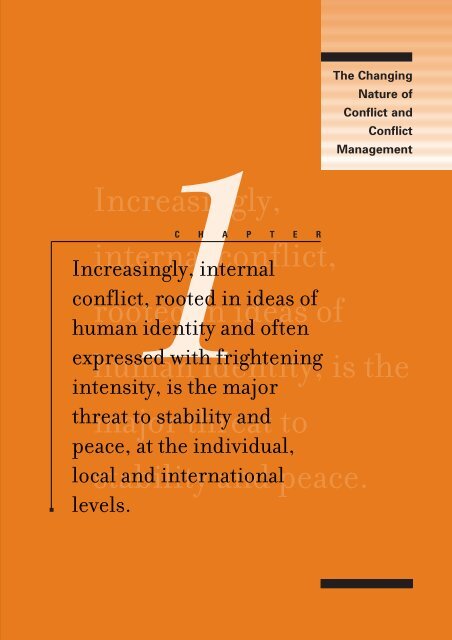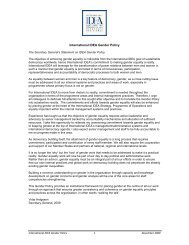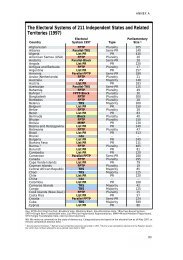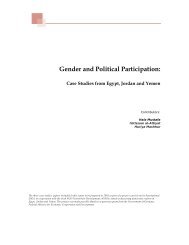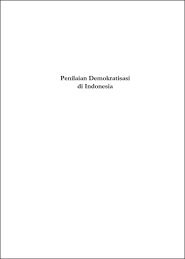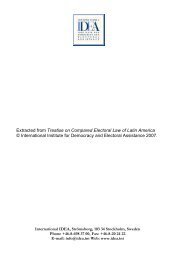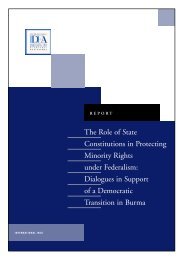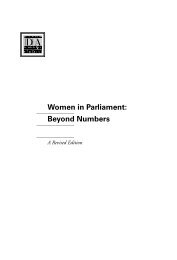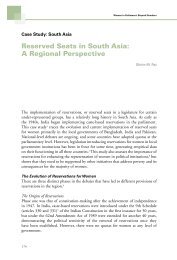THE CHANGING NATURE OF CONFLICT AND ... - International IDEA
THE CHANGING NATURE OF CONFLICT AND ... - International IDEA
THE CHANGING NATURE OF CONFLICT AND ... - International IDEA
Create successful ePaper yourself
Turn your PDF publications into a flip-book with our unique Google optimized e-Paper software.
Democracy and Deep-Rooted Conflict: Options for Negotiators<br />
The Changing Nature of Conflict<br />
and Conflict Management<br />
1<br />
Increasingly,<br />
internal conflict,<br />
rooted in ideas of<br />
human identity, is the<br />
major threat to<br />
C H A P T E R<br />
Increasingly, internal<br />
conflict, rooted in ideas of<br />
human identity and often<br />
expressed with frightening<br />
intensity, is the major<br />
threat to stability and<br />
peace, at the individual,<br />
local and international<br />
levels.<br />
stability and peace.<br />
The Changing<br />
Nature of<br />
Conflict and<br />
Conflict<br />
Management
In this first chapter we examine the changing<br />
nature of conflict – conflict that is increasingly<br />
taking place within states (intra-state) rather<br />
than between states (inter-state) and that is<br />
posing a severe challenge to traditional conflict<br />
management techniques.<br />
1.1 Characteristics of deep-rooted conflict<br />
1.2 New tools for conflict management<br />
1.3–1.4 Why democracy is best suited to manage such conflicts<br />
1.5 Addressing the real causes of conflict<br />
1.6 Distinguishing between process and outcome<br />
1.7 Maximizing women’s participation<br />
1.8 Short- and long-term planning<br />
Factsheet 1 The New State of Conflict: Some Facts<br />
(pp. 14–15)<br />
Box 1 Themes of this Handbook (p. 20)
Democracy and Deep-Rooted Conflict: Options for Negotiators<br />
David Bloomfield<br />
and Ben Reilly<br />
The Changing Nature of Conflict<br />
and Conflict Management<br />
1.1 Characteristics of Deep-Rooted Conflict<br />
In recent years a new type of conflict has come increasingly<br />
to the fore: conflict that takes place within and across states,<br />
or intra-state conflict, in the form of civil wars, armed insurrections,<br />
violent secessionist movements and other domestic<br />
warfare. The change has been dramatic: in the last three years,<br />
for example, every major armed conflict originated at the domestic<br />
level within a state, rather than between states. Two powerful<br />
elements often combine in such conflicts. One is identity:<br />
the mobilization of people in communal identity groups based<br />
on race, religion, culture, language, and so on. The other is distribution:<br />
the means of sharing the economic, social and political<br />
resources within a society. Where perceived imbalance in distribution<br />
coincides with identity differences (where, for example,<br />
one religious group is deprived of certain resources available to<br />
others) we have the potential for conflict. It is this combination<br />
of potent identity-based factors with wider perceptions of economic<br />
and social injustice that often fuels what we call “deeprooted<br />
conflict”.<br />
A striking characteristic of such internal conflict is its sheer<br />
persistence. And this arises, above all, because its origins often<br />
lie in deep-seated issues of identity. In this respect, the term ethnic<br />
conflict is often invoked. Ethnicity is a broad concept, covering<br />
a multiplicity of elements: race, culture, religion, heritage,<br />
history, language, and so on. But at bottom, these are all identity<br />
issues. What they fuel is termed identity-related conflict – in<br />
short, conflict over any concept around which a community of<br />
people focuses its fundamental identity and sense of itself as a<br />
group, and over which it chooses, or feels compelled, to resort<br />
to violent means to protect that identity under threat. Often,<br />
such identity-related factors combine with conflicts over the distribution<br />
of resources – such as territory, economic power, employment<br />
prospects, and so on. Cases where the identity and distributive<br />
issues are combined provide the opportunity for exploitation<br />
and manipulation by opportunistic leaders, and the<br />
highest potential for conflict.<br />
The combination of<br />
potent identity-based<br />
factors with wider<br />
perceptions of<br />
economic and social<br />
injustice often fuels<br />
what we call “deeprooted<br />
conflict”.<br />
9
1.1 Characteristics of<br />
Deep-Rooted Conflict<br />
A conflict in which<br />
one’s community is<br />
deprived of certain<br />
resources is bad<br />
enough; but one may<br />
hope to negotiate a<br />
better deal over those<br />
resources. A conflict<br />
that also threatens our<br />
very sense of who we<br />
are is much more<br />
difficult to manage.<br />
10<br />
Increasingly this kind of conflict, rooted in ideas of human<br />
identity and often expressed with frightening intensity, is the<br />
major threat to stability and peace, whether at the individual,<br />
local and communal levels, or in the collective terms of international<br />
security. Of the 27 conflicts in 1996 classified as “major<br />
armed conflicts” (essentially, over 1000 deaths per year), for<br />
example, fully 22 had a clear identity component to them. These<br />
included conflicts in Russia (Chechnya), Northern Ireland, Iran<br />
and Iraq (with the Kurds), Israel, Afghanistan, Bangladesh<br />
(Chittagong Hill Tribes), Indonesia (East Timor), Sri Lanka,<br />
Burma, Algeria and elsewhere. Only guerrilla-based struggles in<br />
Peru, Cambodia, Guatemala, Colombia and Sierra Leone appeared<br />
to be straightforward contests for power. Even amongst<br />
these cases, there is no shortage of identity-based conflicts. In<br />
sum, the vast majority of contemporary examples of violent<br />
intra-state hostilities exhibit such characteristics.<br />
Such conflicts are clearly very different from the more<br />
straightforward wars between states – over land, resources, political<br />
power, ideology, etc. – of earlier times. (Such wars included<br />
identity elements as well, of course, but usually not in the same<br />
centrally motivating way.) Identity-related conflict is far more<br />
complex, persistent and intractable, instantly much less amenable<br />
to compromise, negotiation or trade-off. These conflicts involve<br />
claims of group rights: national groups, gender groups,<br />
racial groups, religious groups, cultural groups, and so on.<br />
A conflict in which one’s community is deprived of certain<br />
resources is bad enough; but one may hope to negotiate a better<br />
deal over those resources. A conflict that also threatens our very<br />
sense of who we are is much more difficult to manage.<br />
Such complex and fundamental issues, then, fuel wars that<br />
are smaller in scale than the ideological or geopolitical struggles<br />
of the past, but which flourish with much greater intensity. That<br />
is due not only to the depth of meaning invested in them by<br />
combatants, but also to the proliferation and easy availability of<br />
lethal weapons. Since World War Two, cheap, mass-produced,<br />
small-calibre weapons have killed far more people than the<br />
heavier, more traditional battlefield weaponry. With arms markets<br />
flourishing, the Armalite, the Kalashnikov and the land<br />
mine have brought war within the reach of any community with<br />
the will and the means to organize an armed force. This proliferation<br />
of small arms has exponentially increased the intensity of<br />
identity-related conflicts.<br />
Intra-state conflict over identity tends to be persistent over the<br />
long term, alternating between latent phases and outbursts of
Democracy and Deep-Rooted Conflict: Options for Negotiators<br />
1.1 Characteristics of Deep-Rooted<br />
Conflict<br />
sustained violence for periods of years or decades. The scale of<br />
human suffering is breathtaking in this new context. During<br />
World War One, just five per cent of casualties were civilians; by<br />
World War Two the figure had risen to around 50 per cent. But<br />
in the 1990s, the proportion of civilian war casualties has soared<br />
to around 80 per cent. By 1992 there were around 17 million<br />
refugees pushed by war across borders into foreign countries,<br />
and a staggering estimate of a further 20 million displaced persons<br />
rendered homeless by internal war but remaining within<br />
national boundaries (Bosnian victims of ethnic cleansing, for<br />
example). The long-term effect is to militarize the entire society:<br />
violence becomes accepted and institutionalized. Society becomes<br />
brutalized: civilian casualties multiply, rape and starvation<br />
become organized weapons of war, and non-combatants – traditionally<br />
children and women – bear the brunt of the dehumanizing<br />
processes involved in this type of conflict. Such communal<br />
trauma breeds deep and festering wounds and establishes heroes<br />
and martyrs on all sides whose memories and sacrifices<br />
serve to deepen the real and perceived divide between the<br />
conflicting identities.<br />
1.1.1 Identity-driven, emotionally charged<br />
What makes this kind of conflict so prevalent, so pervasive, so<br />
durable and so insoluble, is the way in which the issues of the dispute<br />
are so emotionally charged. They go right to the heart of<br />
what gives people their sense of themselves, defining a person’s<br />
bond with her or his community and defining the source of satisfaction<br />
for her or his need for identity. Since such conflict is by<br />
no means restricted to the so-called developing world, an example<br />
will serve from the heart of the Western establishment. In<br />
the United Kingdom, people in Scotland debate widely among<br />
themselves about the ideal degree of autonomy from England.<br />
The argument ranges from complete independence from, to<br />
complete integration with, Britain. The political debate over<br />
these important issues is spirited; but it does not mobilize into<br />
violence.<br />
Meanwhile, in another part of the UK, people have been<br />
dying violently for centuries over just such a question. Irish<br />
nationalists in Northern Ireland fear that under British rule they<br />
can never achieve full self-expression of their communal identity<br />
as Irish people. Their counterparts, the pro-British Unionists,<br />
fear their disappearance as an identity group if they lose the<br />
union with Britain and join an Irish republic. So while Scots<br />
argue over political control, economic resources and so on, they<br />
do not violently struggle over matters of communal identity and<br />
What makes deeprooted<br />
conflict so<br />
prevalent, so<br />
pervasive, so durable<br />
and so insoluble, is<br />
the way in which the<br />
issues of the dispute<br />
are so emotionaly<br />
charged.<br />
11
1.1 Characteristics of<br />
Deep-Rooted Conflict<br />
In the<br />
interconnectedness of<br />
the modern world and<br />
the instantaneous<br />
transmission of news<br />
(the so-called “CNN<br />
effect”, conflict<br />
respects few<br />
boundaries, borders<br />
or jurisdictions.<br />
12<br />
self-expression, since the UK has apparently satisfied these<br />
needs. In Northern Ireland, the same question goes so deep – to<br />
the heart of people’s fears of who they are and where they belong<br />
in the world – that they leave political debate behind and<br />
resort to violence.<br />
1.1.2 Beyond borders<br />
Internal as its origins may be, however, such conflict has ramifications<br />
far beyond its own geographical borders. Because of<br />
the increasingly complex interdependence among states, such<br />
conflict tends not to be confined within the boundaries of the<br />
particular state for long, if at all, but rapidly diffuses. It spills<br />
over across frontiers and enmeshes other states, or parts of<br />
states, in its grip. This process of diffusion and contagion means<br />
that low-level intra-state conflicts can potentially escalate into<br />
more intense inter-state ones.<br />
Several factors contribute to this spillover effect. Neighbouring<br />
governments will have a strong self-interest in supporting<br />
one side or another of an adjacent civil war, and their own reasons<br />
for seeing the stabilization or destabilization of the state in<br />
conflict. Quite apart from governments, population groups do<br />
not necessarily neatly reside within state borders. There may be<br />
large diaspora populations outside the state – refugee or emigrant<br />
communities, or a section of a community cut off by partition<br />
– who engage with the conflict through close identification<br />
with one side or another. Hutus and Tutsis outside Rwanda,<br />
Tamils outside Sri Lanka and Basques outside Spain are only a<br />
few among many examples. Beyond the immediate context, of<br />
course, there exist more distant states, powers or regional blocs,<br />
whose interests are directly concerned with the outcome of the<br />
conflict: for instance, the European Union’s security concerns<br />
over Bosnia, US interests in Central America, Russian involvement<br />
in Georgia, and so on. Such factors immediately extend<br />
the geography of the conflict, adding to its complexity as well as<br />
its scale. In the interconnectedness of the modern world and the<br />
instantaneous transmission of news (the so-called “CNN effect”),<br />
conflict respects few boundaries, borders or jurisdictions.<br />
When it comes to managing such conflict, its complexities<br />
cause immense difficulties. There can even be a difficulty in correctly<br />
identifying the parties to the conflict. The picture is even<br />
more confused when we factor in the external sponsors of the<br />
conflict. Sponsors, regional allies, kin states or whatever, will
Democracy and Deep-Rooted Conflict: Options for Negotiators<br />
1.2 New Tools for Conflict<br />
Management<br />
usually be operating in general support of one side’s agenda,<br />
while also bringing their own specific agenda and interests to<br />
the conflict. The result can be a degree of interference, which<br />
actually reduces the disputing parties’ chances of resolving the<br />
conflict. With so many factions involved, both internal and<br />
external, the task of satisfying the key interests of the various<br />
actors makes a solution far more difficult to achieve. It also<br />
makes the conflict management process more prone to abuse<br />
and disruption.<br />
1.2 New Tools for Conflict Management<br />
Many existing conflict management tools were constructed<br />
during, and in response to, world wars and the Cold War. The<br />
narrow, containment-oriented strategies of coercion and crisismanagement<br />
that prevailed during the era of superpower rivalry<br />
have been exposed as arthritic, inflexible and increasingly impotent<br />
against a wave of reinvigorated intra-state, identity-driven,<br />
deep-rooted conflicts. The Cold War froze many such deep-rooted<br />
conflicts, so that they simply went into a latent phase, invisible<br />
on the surface but with their roots as deep as ever. Cold War<br />
strategists focused on short-term stability rather than longerterm<br />
sustainability. What is needed now is a new range of flexible<br />
and adaptable instruments that can take into account the more<br />
subjective, complex and deep-rooted needs and interests that<br />
underpin identity-related conflict.<br />
It is the aim of this handbook not to engage too deeply in the<br />
somewhat philosophical, if important, argument about overall<br />
approaches to conflict management, but to concentrate on<br />
developing the resources and the materials for doing the job by<br />
assisting the construction of settlements that properly address all<br />
the aspects of a conflict. To this end, the following chapters offer<br />
tools for designing good conflict management processes,<br />
and the basic building blocks for putting in place sustainable,<br />
durable and flexible solutions to conflict. There is a premium<br />
placed on democratic outcomes, but democracy itself is not a<br />
panacea. Democratic states suffer from conflicts just as others<br />
do, and the presence of democracy is no guarantee of a society<br />
without political violence. But – and this is a major theme of this<br />
handbook – democratic societies tend to develop the institutions,<br />
resources and flexibility, in the long term, to peacefully<br />
manage these kinds of conflict.<br />
Today’s predominant<br />
pattern of conflict is<br />
proving resistant to<br />
the available and<br />
accepted tools of<br />
conflict management.<br />
13
<strong>THE</strong> NEW STATE <strong>OF</strong> <strong>CONFLICT</strong>: SOME FACTS<br />
Deep-Rooted Conflict: Conflict, originating largely within<br />
states, which combines two powerful elements: potent<br />
identity-based factors, based on differences in race, religion,<br />
culture, language and so on, with perceived imbalance in the<br />
distribution of economic, political and social resources.<br />
Characteristics: complex, persistent, and intractable; much less<br />
amenable to compromise, negotiation or trade-off; rapidly diffuses<br />
beyond the boundaries of the particular state.<br />
Intra-state, not inter-state. In the last three years, every major armed<br />
conflict originated at the domestic level within a state (intra-state),<br />
rather than between states (inter-state).<br />
Of the 101 armed conflicts during 1989-1996, only six were inter-state.<br />
The remaining 95 took place within existing states.<br />
Identity-based. Of the 27 conflicts in 1996 classified as “major armed<br />
conflicts” (more than 1,000 dead per year), 22 had a clear identity<br />
component to them.<br />
New weapons of war. Since World War Two, cheap, mass-produced,<br />
small-calibre weapons have killed far more people than the heavier<br />
more traditional battlefield weaponry.<br />
Civilian casualties. During World War One, five per cent of casualties<br />
were civilian; by World War Two the figure had risen to 50 per cent. In<br />
the 1990s, the proportion of civilian casualties has soared to 80 per cent.<br />
Refugees. By 1992, there were about 17 million refugees, and a further<br />
20 million people who were internally displaced.<br />
Examples. Deep-rooted conflicts include Russia (Chechnya), Northern<br />
Ireland, Iran and Iraq (with the Kurds), Israel, Afghanistan,<br />
Bangladesh (Chittagong Hill Tribes), Indonesia (East Timor), Sri<br />
Lanka, Burma, Algeria and elsewhere.<br />
Source: SIPRI Yearbook 1997: Armaments, Disarmament and <strong>International</strong> Security.<br />
Oxford: Oxford University Press for SIPRI.<br />
FACTSHEET 1 [P. 14]
<strong>THE</strong> NEW STATE <strong>OF</strong> <strong>CONFLICT</strong>: SOME FACTS<br />
Rising Rate of Civilian Casualties<br />
The percentage of civilian casualties<br />
soared from five per cent during WWI<br />
to 80 per cent during the 1990s.<br />
Source: Ramsbotham, Oliver,<br />
and Tom Woodhouse. 1996.<br />
Cost of United Nations<br />
Peace-keeping Operations<br />
1986–1997<br />
The cost of peace-keeping has risen<br />
from less than $US 200 million to over<br />
$US 1 billion in the last ten years.<br />
Source: Peace-keeping Financing<br />
Division /DPKO/UNHQ.<br />
(millions of US$)<br />
5%<br />
50%<br />
80%<br />
’90s<br />
WW II<br />
WW I<br />
183.7<br />
180.4<br />
205.2<br />
568.5<br />
357.7<br />
427.9<br />
1,675.8<br />
2,970.2<br />
3,226.4<br />
’94<br />
’93<br />
’92<br />
’91<br />
’90<br />
’89<br />
’88<br />
’87<br />
’86<br />
2,565.4<br />
1,467.5<br />
’95<br />
1,175.1<br />
’96<br />
’97<br />
Global Refugee Population 1978–1997<br />
The number of refugees has nearly quadrupled<br />
in the last two decades.<br />
Source: UNHCR<br />
Statistic at January each year. Totals<br />
do not include other groups of concern<br />
to UNHCR and Palestinians assisted<br />
by the UN Relief and Works<br />
Agency for Palestine Refugees<br />
in the Near East.<br />
Internally<br />
Displaced Persons<br />
During the 1990s<br />
The number of internally<br />
displaced persons (IDPs)<br />
reached 26 million in 1994.<br />
Source: U.S. Committee<br />
for Refugees. (Figures<br />
taken from: World<br />
Refugee Statistics.)<br />
3,778,000<br />
4,576,000<br />
5,692,000<br />
’79<br />
’78<br />
8,229,000<br />
9,826,000<br />
’81<br />
’80<br />
10,376,000<br />
10,883,000<br />
’83<br />
’82<br />
10,506,000<br />
11,613,000<br />
’85<br />
’84<br />
12,396,000<br />
13,272,000<br />
’78<br />
’86<br />
14,779,000<br />
14,916,000<br />
’89<br />
’88<br />
17,198,000<br />
’90<br />
17,008,000<br />
’91<br />
18,189,000<br />
’92<br />
16,402,000<br />
’93<br />
14,489,000<br />
’94<br />
13,237,000<br />
’95<br />
13,200,000<br />
’96<br />
’97<br />
More than 20 Million IDPs<br />
More than 23 Million IDPs<br />
More than 24 Million IDPs<br />
’91<br />
’90<br />
More than 25 Million IDPs<br />
More than 26 Million IDPs<br />
More than 20 Million IDPs<br />
More than 19 Million IDPs<br />
More than 17 Million IDPs<br />
’97<br />
’96<br />
’95<br />
’94<br />
’93<br />
’92<br />
FACTSHEET 1 [P. 15]<br />
© <strong>International</strong> <strong>IDEA</strong>
1.3 The Importance of<br />
Democratic Institutions<br />
Democratic structures<br />
can offer an effective<br />
means for the peaceful<br />
handling of deeprooted<br />
conflict through<br />
inclusive, just and<br />
accountable<br />
frameworks.<br />
16<br />
1.3 The Importance of Democratic Institutions<br />
Three central themes dominate this handbook. The first is<br />
the crucial role that appropriate democratic political structures<br />
play in forging an enduring settlement to an internal conflict. It<br />
is important to understand that there is no single or simple<br />
model of democracy. Those wishing to build a sustainable settlement<br />
to a conflict have often overlooked the importance of<br />
making appropriate institutional choices about systems of governance.<br />
Seldom do they have access to all the information necessary<br />
to make informed decisions about which institutions<br />
might best suit their particular needs. This handbook attempts<br />
to fill this gap. The choice of appropriate democratic institutions<br />
– forms of devolution or autonomy, electoral system design,<br />
legislative bodies, judicial structures, and so on – designed<br />
and developed through fair and honest negotiation processes,<br />
are vital ingredients in building an enduring and peaceful settlement<br />
to even the most intractable conflict. Conversely, the<br />
international scene is littered with post-conflict settlements that<br />
broke down in part because of inappropriate and unsustainable<br />
institutional choices for deeply divided societies. Selecting unsuitable<br />
institutions can increase the possibility of a conflict persisting<br />
or even escalating.<br />
At Bicesse in 1991, for example, parties to the Angolan conflict<br />
built an agreement by focusing on the goal of holding democratic<br />
elections which, it was presumed, would lead to a subsequent<br />
power sharing among the parties in a coalition government.<br />
However, the Angolan constitution was unsuited to support<br />
the power-sharing government which the Bicesse process<br />
aimed to bring about, since it concentrated political power not<br />
in a broad-based and inclusive parliament but in the hands of<br />
one person – the president. With both the incumbent government<br />
of President dos Santos and guerrilla leader Jonas Savimbi<br />
competing for the office of president – the only prize worth having<br />
in the context of the Angolan Constitution – the loser had a<br />
greater incentive to opt out of the political transition and resume<br />
fighting than to stay inside the process in a powerless position.<br />
And this was precisely what happened: Savimbi expected to lose<br />
the second round of the 1992 election and the fighting immediately<br />
resumed. One of the reasons why this settlement did<br />
not last may have been the lack of a system that realistically<br />
enabled both parties to share power (although as we are seeing
Democracy and Deep-Rooted Conflict: Options for Negotiators<br />
1.4 Democracy and Conflict<br />
Management<br />
at the time this publication goes to press, August 1998, it may<br />
not have been the only reason).<br />
Democracy, like any other political system, is not without its<br />
flaws in this imperfect world. But in the absence of a better alternative,<br />
experience from around the world convinces us that democratic<br />
structures, in their myriad permutations, can offer an<br />
effective means for the peaceful handling of deep-rooted difference<br />
through inclusive, just and accountable social frameworks.<br />
Democratic systems of government have a degree of legitimacy,<br />
inclusiveness, flexibility and capacity for constant adaptation<br />
that enables deep-rooted conflicts to be managed peacefully.<br />
Moreover, by building norms of behaviour of negotiation, compromise,<br />
and co-operation amongst political actors, democracy<br />
itself has a pacifying effect on the nature of political relations<br />
between people and between governments.<br />
Despite the importance of democracy and democratic solutions,<br />
however, poorly designed democratic institutions can also<br />
inflame communal conflicts rather than ameliorate them. And<br />
the introduction of “democratic” politics can easily be used to<br />
mobilize ethnicity, turning elections into “us” versus “them” conflicts.<br />
In deeply divided societies, a combination of majoritarian<br />
political institutions and elections can often make things worse.<br />
Other democratic institutions that lend themselves towards divisive,<br />
yes or no political campaigns, such as referendums, can also<br />
have negative effects in divided societies. That is why basic<br />
democratic values such as pluralism, tolerance, inclusiveness,<br />
negotiation, and compromise are keys to building lasting settlements<br />
to conflicts. Often, the institutional embodiment of these<br />
values requires institutions that emphasize different features<br />
than simple winner-take-all majority rule: features such as power<br />
sharing, autonomy, proportionality, forms of group recognition,<br />
and so on. These themes will reappear throughout this handbook.<br />
1.4 Democracy and Conflict Management<br />
The second theme of this handbook concerns moving away<br />
from thinking about the resolution of conflict, towards a more<br />
pragmatic interest in conflict management. This is an important<br />
distinction. Conflict resolution suggests the ending or removal of a<br />
conflict. The implication is that conflict is a negative phenomenon,<br />
which should be resolved, ended, and eradicated. On the<br />
contrary, conflict can be positive as well as negative. Conflict is<br />
the interaction of different and opposing aspirations and goals<br />
17
1.4 Democracy and<br />
Conflict Management<br />
Democracy operates<br />
as a conflict<br />
management system<br />
without recourse to<br />
violence.<br />
18<br />
in which disputes are processed, but not definitively resolved. It<br />
is a necessary part of healthy democratic debate and dialogue,<br />
provided it remains within the boundaries of the commonly<br />
accepted “rules of the democratic game”. The violent expression<br />
of conflict is its destructive side. But conflict can be the starting<br />
point for energizing social change and improvement. Conflict<br />
management, then, is the positive and constructive handling of<br />
difference and divergence. Rather than advocating methods for<br />
removing conflict, this handbook addresses the more realistic<br />
question of managing conflict: how to deal with it in a constructive<br />
way, how to bring opposing sides together in a co-operative<br />
process, how to design a practical, achievable, co-operative system<br />
for the constructive management of difference.<br />
This handbook is relatively unusual in putting a premium<br />
upon the need for negotiated settlements that are based on<br />
democratic outcomes. But there are good historical reasons for<br />
skepticism about the track record of negotiated settlements to<br />
deep-rooted conflicts. Scholars point to 20th century experience<br />
that reflects the fact that only 15 per cent of internal conflicts<br />
end in negotiated settlements. Most have ended in military victories.<br />
Moreover, many (roughly half) of those that have ended<br />
in negotiations fail within five years (disputants return to the<br />
battlefield, as they did in Sudan in 1984 following a peace accord<br />
that had been reached in 1972). For this reason, some<br />
scholars point to partition as the only answer to identity-based<br />
conflict. However, in the post-Cold War period, there have clearly<br />
been many more settlements to violent internal conflicts than<br />
in the past, and almost half of the internal conflicts that have<br />
ceased in the last eight years ended through negotiation. We<br />
know intuitively that negotiated settlements are much more likely<br />
in the post-Cold War era than before. Moreover, even when<br />
military victory occurs (as in Zaire/Democratic Republic of Congo),<br />
issues of democracy continue to be raised making a resumption<br />
of conflict far more likely. Although it is important to keep<br />
the historical record in mind, recent experience shows a clear<br />
swing towards negotiated settlements in which issues of democracy<br />
building are paramount.<br />
Our emphasis on democracy is not an ideological conviction.<br />
On the contrary, it is a pragmatic argument based on wide experience<br />
and study. Democracy is presented in this handbook not<br />
only as a guiding principle, but as a workable system for the positive<br />
management of conflict. Our definition of democracy is a
Democracy and Deep-Rooted Conflict: Options for Negotiators<br />
1.4 Democracy and Conflict<br />
Management<br />
practical one. For a system of government to be considered democratic,<br />
it must combine three essential conditions: meaningful<br />
competition for political power amongst individuals and organized<br />
groups; inclusive participation in the selection of leaders<br />
and policies, at least through free and fair elections; and a level<br />
of civil and political liberties sufficient to ensure the integrity of<br />
political competition and participation. Participation and contestation<br />
are crucial: while democracy can take many forms, no<br />
system can be called democratic without a meaningful level of<br />
both.<br />
A 1993 study of 233 internal conflicts around the world found<br />
that democracies had a far better record of peacefully managing<br />
such conflicts than alternative systems. The evidence for the<br />
“democratic peace” proposition – the empirical fact that democracies<br />
are far less likely to go to war with each other than other<br />
regime types – lends further support to this relationship between<br />
conflict and democracy. Authoritarian or totalitarian systems<br />
simply do not have the institutions by which such conflicts<br />
can be peacefully expressed and resolved. They generally try to<br />
deal with such conflicts by ignoring or denying them, by suppressing<br />
them or by attempting to eliminate them. While some<br />
conflicts can indeed be controlled in this way, albeit usually at<br />
severe cost, deep-rooted conflicts generally cannot. The type of<br />
fundamental issues of identity and cultural integrity inherent in<br />
such conflicts mean that almost nothing, short of mass expulsions<br />
or genocide, will make them disappear. The ethnic conflict<br />
that erupted in the former Yugoslavia in 1990, for example,<br />
had been suppressed and held in check for almost 50 years during<br />
the years of the Eastern Bloc, but it was always present and<br />
unresolved. Authoritarian systems can present an illusion of<br />
short-term stability, but are unlikely to be sustainable over the<br />
long term.<br />
Under a democracy, by contrast, disputes arise, are processed,<br />
debated and reacted to, rather than being resolved definitively<br />
and permanently. All outcomes are temporary, as the loser today<br />
may be the winner tomorrow. Unlike other systems, democratic<br />
government permits grievances to be expressed openly and responded<br />
to. In short, democracy operates as a conflict management<br />
system without recourse to violence. It is this ability to handle<br />
conflicts without having to suppress them or be engulfed by<br />
them which distinguishes democratic government from its major<br />
alternatives. This does not mean that democracy is perfect,<br />
19
1.5 Addressing the Real<br />
Causes of Conflict<br />
or that democratic governance will itself lead to peaceful outcomes.<br />
There are a number of cases of democratic institutions<br />
being hastily “transplanted” to post-conflict societies without<br />
taking root, or with a subsequent resumption of hostilities – the<br />
case of Burundi, for example, or Cambodia. But it is equally true<br />
that these cases have many lessons in terms of how deals are<br />
struck and which choices are made that are of crucial importance<br />
to building a sustainable outcome. Democracy is often messy,<br />
incremental, and difficult, but it is also by far the best hope of<br />
building sustainable settlements to most of the conflicts being<br />
fought around the world today.<br />
Box 1<br />
<strong>THE</strong>MES <strong>OF</strong> THIS H<strong>AND</strong>BOOK<br />
Three central themes dominate this handbook:<br />
1. Importance of Democratic Institutions<br />
Democracy provides the foundation for building an<br />
effective and lasting settlement to internal conflicts.<br />
Therefore making appropriate choices about democratic<br />
institutions – forms of devolution or autonomy, electoral<br />
system design, legislative bodies, judicial structures, and<br />
so on – is crucial in building an enduring and peaceful<br />
settlement.<br />
2. Conflict Management, not Resolution<br />
There needs to be move away from thinking about the<br />
resolution of conflict towards a more pragmatic interest<br />
in conflict management. This handbook addresses the<br />
more realistic question of managing conflict: how to<br />
deal with it in a constructive way, how to bring<br />
opposing sides together in a co-operative process, how<br />
to design a practical, achievable, co-operative system for<br />
the constructive management of difference.<br />
3. The Importance of Process<br />
The process by which parties reach an outcome impacts<br />
significantly on the quality of the outcome. Attention<br />
must be paid to every aspect of the process of<br />
negotiations in order to reach a durable outcome.<br />
20<br />
1.5 Addressing the Real Causes of Conflict<br />
Conflict management is one of the most difficult and complex<br />
tasks that can face human beings, both individually and col-
Democracy and Deep-Rooted Conflict: Options for Negotiators<br />
1.5 Addressing the Real Causes<br />
of Conflict<br />
lectively. Even without time-pressures and political tensions, it is<br />
a supreme challenge. But in the real world, such factors are always<br />
present. Their effect is manifest as intense pressure to produce<br />
results, irrespective of the difficulty of the task. The nearirresistible<br />
temptation is to respond by simplifying the task, and<br />
focusing on surfaces and symptoms, searching for the fastest way<br />
to some result. But speed does not equate with quality. A simplistic<br />
approach cannot wholly succeed in addressing a complex<br />
problem. The kind of conflict we are addressing here – that<br />
which results in prolonged violence, that which comes about<br />
over deep-seated and profound differences – is caused at a much<br />
deeper level. Hence the term deep-rooted conflict. If conflict were<br />
simply a surface phenomenon, it would be easily dealt with at<br />
the surface level. But deep-rooted conflict demands deep-rooted<br />
conflict management. A doctor who treats a patient’s symptoms<br />
may bring short-term relief of suffering. But a doctor who treats<br />
and cures the underlying illness that caused the symptoms<br />
brings a long-term solution to the patient’s problem. In conflict<br />
management there needs to be a shift of focus, beyond the surface<br />
approach of treating symptoms, to a deeper level where underlying<br />
illnesses are directly addressed.<br />
However, any doctor will rightly argue that treating symptoms<br />
is a vital humanitarian act, bringing short-term relief of suffering.<br />
A negotiation process that fails abysmally in its attempt to<br />
design a long-term settlement, but achieves a six-month ceasefire,<br />
has saved many lives. We must therefore not decry the genuine<br />
value of short-term measures, especially in situations of desperation<br />
and suffering. But the point is simply that short-term<br />
pain relief should not be confused with long-term cure. This is<br />
not to blame politicians and negotiators for yielding to pressures<br />
that are part and parcel of political life but simply to acknowledge<br />
that, within the pressures of the situation, a shift in focus<br />
beyond the immediate to the longer term, a reorientation from<br />
the surface symptoms to their underlying cause, is vital for both<br />
the short-term process and the long-term future. Failure to<br />
make this shift will inevitably harm the entire process as well as<br />
the future result. Ultimately, it may even make the situation<br />
worse than before. The challenge then, for domestic and international<br />
actors, is to seriously consider the temptation of shortterm<br />
stability (and quick rewards and success) and move towards<br />
the long-term objective of a sustainable settlement.<br />
A shift in focus beyond<br />
the immediate to the<br />
longer term, a<br />
reorientation from the<br />
surface symptoms to<br />
their underlying<br />
cause, is vital for both<br />
the short-term process<br />
and the long-term<br />
future.<br />
21
1.6 Process and<br />
Outcome<br />
Process asks: how do<br />
we get to a solution?<br />
Outcome asks: what<br />
do we include in that<br />
solution?<br />
22<br />
1.6 Process and Outcome<br />
The third theme of this handbook is that the process of designing<br />
negotiations is critical to the success and durability of the<br />
outcome. In thinking about the search for a settlement, a useful<br />
distinction can be made between process and outcome. Process is<br />
the business of negotiation and dialogue. If conflicting parties<br />
now need to discuss the elements of a solution, how exactly<br />
should that discussion be structured? For example, would the<br />
intervention of a third party be useful or distracting? What types<br />
of third-party intervention might be used, and how have they<br />
worked, or failed, in the past? Who exactly should participate in<br />
the talks process? Leaders only? Political parties? Non-governmental<br />
agencies? Outside observers? Would a time-limit on talks<br />
help or hinder the process? Should the talks be secret or public?<br />
What are the issues involved in choosing a venue for negotiations?<br />
These and many other pertinent questions need to be<br />
addressed in order to design the optimum process, the one that<br />
offers the best hope of a successful outcome.<br />
The answers depend on the specific situation under discussion.<br />
From an analysis of the conflict – identifying its history, its<br />
core issues, its participants, and so on – one identifies the factors<br />
which need to go into the design of a suitable process. From an<br />
overview of many conflicts and peace processes around the<br />
world, this handbook directs readers to the most critical factors<br />
that they will need to consider, and then helps them to find the<br />
answers pertinent to their specific context.<br />
Process involves every aspect of the way parties get to an outcome.<br />
The type of process used, of course, impacts significantly<br />
on the quality of the outcome. In particular, a sound process<br />
helps to contribute to the legitimacy of the outcome. For example,<br />
if the process employed is an inclusive one, where all parties<br />
who claim an interest in the conflict feel involvement in it, feel<br />
they have been heard and their views respected, and feel that<br />
the process has permitted them to make a contribution to the<br />
ultimate settlement, they are far more motivated to put subsequent<br />
effort into making that settlement work. In contrast, a<br />
group who feel excluded from the process will be far more likely<br />
to question the legitimacy of the settlement and to obstruct<br />
efforts to implement it. So good process not only makes for efficient<br />
working practice, it also strengthens the outcome. It is an<br />
essential ingredient for a durable, long-term solution.<br />
Outcome focuses not on the way to reach a solution, but on the<br />
substance of that solution itself. Democratic structures and insti-
Democracy and Deep-Rooted Conflict: Options for Negotiators<br />
1.6 Process and Outcome<br />
tutions offer practical components for a successful outcome,<br />
because their democratic nature implies a degree of consensus<br />
and accountability in their implementation. As with good process,<br />
the design of a sound outcome again lessens the chance of<br />
any party subsequently feeling the solution has been imposed<br />
upon them and thus questioning its legitimacy. What sort of political<br />
structures will be the components of the solution over<br />
which the parties negotiate during the process? What are the various<br />
kinds of democratic institutions that have been negotiated<br />
as settlements in the past? What were their strengths, and their<br />
weaknesses? What roles can outside agents usefully play in implementing<br />
or supporting these institutions? The business of mutually<br />
thinking these questions through to agreement will contribute<br />
to a better method of building sustainable and just systems<br />
of democratic government. In sum, the sustainability of a<br />
solution depends both on its outcome – its character and its content<br />
– and on the process by which it was agreed.<br />
It is an analytic exercise to separate process and outcome<br />
completely. The distinction is offered as a useful method of concentrating<br />
on different but equally important aspects of conflict<br />
management. But in reality they are tightly intertwined and interdependent.<br />
Bad process will greatly impede agreement. It<br />
can even contribute to ultimate failure, no matter how well designed<br />
the outcome, simply because the way in which the talks<br />
were structured may cause friction and distrust and leave at<br />
least some parties questioning the legitimacy of the whole venture.<br />
Likewise the best process cannot guarantee success or sustainability<br />
if the outcome is poorly designed, is imposed on some of<br />
the parties or does not satisfy their real interests, no matter how<br />
fairly the process of dialogue was constructed. In practice, some<br />
parties will want assurances on what the broad parameters of the<br />
outcome will be before they agree to talks.<br />
It is worth noting here that many of the conflict situations<br />
which readers will bring to the handbook have attracted the attention<br />
and involvement of the international community, increasingly<br />
in the form of third-party intervention or mediation.<br />
Third-party intervention can be of significant assistance in a conflict<br />
situation and is dealt with in more detail in Chapter 3. But<br />
parties need to be aware that there may also be dangers. Third<br />
parties may bring their own agendas, benign or otherwise: their<br />
own substantive interests in the issues of the conflict, perhaps<br />
their own desire for international acclamation as directors of the<br />
peace process, and so on. Mediators may focus too much on<br />
23
1.7 Maximizing<br />
Women’s Participation<br />
Women should be<br />
included around the<br />
negotiating table<br />
because their<br />
experiences, values<br />
and priorities, as<br />
women, can bring a<br />
perspective that can<br />
help find a solution to<br />
the conflict.<br />
24<br />
process at the expense of outcome and often lack the necessary<br />
expertise in relation to institutional options. In addition, powerful<br />
intervenors may be tempted to force parties into a superficial<br />
agreement that fails to address underlying interests and needs,<br />
thus simply storing up trouble for the future.<br />
1.7 Maximizing Women’s Participation<br />
In all conflicts, particularly those in which deep-seated identity<br />
issues are prominent, it is the most vulnerable members of<br />
society who often pay the highest cost. One of the characteristics<br />
of contemporary, intra-state conflicts is that the most marginalized<br />
social groups – small ethnic minorities, indigenous peoples<br />
and so on – are the most affected. Indeed, in some conflicts it is<br />
these very groups, such as the Kurdish peoples who are often<br />
described as the world’s largest stateless ethnic group, who are<br />
directly targeted as victims.<br />
Similarly, in almost all contemporary within-state conflicts,<br />
civilians in general, and women and children in particular, feature<br />
disproportionately amongst the casualty list. This makes the<br />
issue of gender a particularly salient feature of peace building.<br />
While the aggressors in today’s conflicts, and the armies that<br />
fight them, continue to be predominantly male, the high casualty<br />
rates of civilians means that it is often women who bear the brunt<br />
of the consequences of the conflicts, a factor only emphasized by<br />
the effect of such conflicts on children.<br />
It is therefore vital that any attempt at rebuilding democracy<br />
in the wake of a violent ethnic conflict builds women into the<br />
process as much as possible. In fact, in many cases this does not<br />
happen – the same people who started the conflict are also those<br />
who negotiate its end. This has detrimental effects on the longterm<br />
sustainability of a settlement, because vital voices and interests<br />
are not heard. This can be addressed by building gender<br />
considerations into every aspect of the peace process.<br />
In the pre-negotiation phase, for instance, it is important to<br />
identify all constituencies, and to structure the process so as to<br />
maximize their participation. During the negotiations itself, it is<br />
essential that efforts are made to include considerations of gender,<br />
both thematically and via the representation of women as<br />
parties to the negotiations – rather than as being observers locked<br />
out of a process driven and dominated by men. During the implementation<br />
phase, each and every political institution needs to<br />
be structured such that it incorporates issues of gender and<br />
addresses wider issues of equality. This can take place both at a
Democracy and Deep-Rooted Conflict: Options for Negotiators<br />
1.8 Short- and Long-Term Planning<br />
macro-level – through, for example, consideration of issues of<br />
gender and equality when designing political institutions – and<br />
at a more micro-level, via the establishment of specific mechanisms<br />
for gender equality (see the specific section on this issue<br />
in Chapter 4).<br />
Beyond such structuring of mechanisms, however, there needs<br />
to be a recognition of the importance of involving women in the<br />
negotiation process because of what they, as women, can bring<br />
to the process of finding peace. Women should be included<br />
around the negotiating table because their experiences, values<br />
and priorities, as women, brings a perspective that is important<br />
and valuable to both process and outcome.<br />
1.8 Short- and Long-Term Planning<br />
The management of post-conflict democratic peace building<br />
is first and foremost the management of political time in a complex<br />
and highly volatile context. From the moment peace negotiations<br />
start, the pressure is intense on those involved to reach<br />
agreement as quickly as possible. That pressure often becomes<br />
irresistible. Time may be very limited. Political demands for fast<br />
results may be overwhelming. In a context of ongoing violence,<br />
many lives may be at stake. The temptation is to push for superficial<br />
success at the expense of concentration on the outcome.<br />
The need to reach an agreement – any agreement – becomes<br />
more important than the quality of the agreement, especially its<br />
all-important elements of sustainability and durability. Longterm<br />
stability is sacrificed for short-term expediency. This pressure<br />
can build from many sources: a limited window of opportunity<br />
for talks; a tenuous cease-fire agreement that may collapse<br />
without quick results; the influence of outside actors who need<br />
their own results; the limited patience of a constituency who<br />
demand immediate improvements or guarantees; military issues,<br />
economic needs and contingencies, and so on.<br />
These pressures are genuine and difficult to resist. Nonetheless,<br />
time spent in the dialogue phase pays off afterwards. There<br />
is always a trade-off between the urgent pressure for a result in<br />
response to the immediate circumstances, and the time needed<br />
to build a sustainable outcome with long-term stability. A slowfast<br />
approach to conflict management is one where the initial<br />
stage of reaching agreement is done as slowly as necessary, to ensure<br />
that the agreement, when reached, is as comprehensive<br />
and detailed as possible. This permits more speed subsequently<br />
in implementing the agreement. By contrast, many agreements<br />
There is a need to<br />
balance the necessity<br />
of achieving results<br />
from negotiation<br />
against the stability<br />
and longevity of the<br />
outcome – a need, in<br />
other words, to<br />
balance short- and<br />
long-term goals.<br />
25
1.8 Short- and Long-<br />
Term Planning<br />
26<br />
are reached in a fast-slow mode: pressure for results encourages<br />
the parties to rush through the negotiation phase and reach a<br />
less than optimum agreement, so that problems remain which<br />
slow down, or altogether obstruct, the implementation phase.<br />
The fast-slow approach was exemplified when, in November<br />
1995, Bosnian leaders endured intensive pressure from their US<br />
hosts during negotiations in Dayton, Ohio. The US agenda –<br />
which included, in significant part, a strong White House desire<br />
for demonstrable negotiating successes in Bosnia, the Middle<br />
East and Northern Ireland – as well as the domestic constituencies<br />
of the Bosnian parties, placed a premium on an agreement<br />
being reached. This agenda, coupled with the extreme urgency<br />
of ending a vicious and devastating war, meant that intense pressure<br />
was applied on the three Bosnian leaders and their delegates<br />
at Dayton not to leave the site without a signed result on<br />
paper. The resulting Dayton Peace Accords were acclaimed as<br />
the framework for a comprehensive settlement of the conflict in<br />
Bosnia. But in the rush to reach an agreement, many details had<br />
to be overlooked. The effect was to sacrifice long-term planning<br />
for short-term results: the insistence on a fast result at the negotiation<br />
stage simply piled up problems which remained to obstruct<br />
and delay the implementation of the Accords (see Bosnia<br />
Case Study). On the other hand, it stopped the war and the killing,<br />
which was a great achievement. It is not suggested that these two<br />
approaches are necessarily exclusive, rather that they need to be<br />
balanced as much as possible.<br />
In some important ways, the South African constitutional negotiations<br />
of the early 1990s stand as a successful example of the<br />
reverse, a slow-fast approach. The negotiation process was at<br />
times painstakingly slow, not least because of the wide range of<br />
participating groups and factions as well as the complexity of the<br />
issues. Undoubtedly, an outcome could have been designed<br />
much more rapidly between just the major participants, the government<br />
and the African National Congress (ANC), and by leaving<br />
certain aspects for later resolution. But the apparently interminable<br />
talking between so many parties and the variety of<br />
issues addressed, which made the negotiation stage so slow, paid<br />
considerable rewards in the implementation phase, when the<br />
multilateral nature of the talks made the subsequent “sell” much<br />
faster and avoided breakdowns as a result of “constituency lag”<br />
between leaders and their supporters. When eventually signed,
Democracy and Deep-Rooted Conflict: Options for Negotiators<br />
1.8 Short- and Long-Term Planning<br />
the legitimacy of the outcome was far stronger than a more<br />
exclusive version would have been.<br />
Perhaps in an ideal world, conflicting parties would have the<br />
luxury of a slow-slow approach – one where every stage of the settlement<br />
process is given sufficient time to attend to every detail.<br />
But such luxury is rarely available. Indeed, the most frequent<br />
pressure is for a fast-fast approach, the worst possible scenario,<br />
where there is no time to do justice to any aspect of the conflict<br />
management process. Avoiding both of these unlikely or unproductive<br />
extremes, we simply highlight the tension between fastslow<br />
and slow-fast, and emphasize the long-term value of the latter.<br />
There is a need, then, to balance the necessity of achieving<br />
results from negotiation against the stability and longevity of the<br />
outcome, a need, in other words, to balance short- and longterm<br />
goals. So a compromise that may appear to be the best<br />
achievable result in the urgent present tense of the negotiating<br />
process can often prove too weak to be sustainable in the future.<br />
The effect is simply to postpone, rather than solve, problems.<br />
While recognizing the difficulty of the advice, experience from<br />
around the world repeatedly teaches the value of retaining a<br />
strong sense of future ramifications during the design stage.<br />
Attention paid to detail in that earlier negotiation phase will<br />
save much time, and possibly the whole settlement, during the<br />
subsequent phase of implementation.<br />
REFERENCES <strong>AND</strong> FUR<strong>THE</strong>R READING<br />
Diamond, Larry, Juan Linz and Seymour Martin Lipset.<br />
1995. Politics in Developing Countries: Comparing Experiences<br />
with Democracy. Boulder and London: Lynne Reiner<br />
Publishers.<br />
Gurr, Ted Robert. 1993. Minorities at Risk: A Global View of<br />
Ethnopolitical Conflicts. Washington, DC: United States<br />
Institute of Peace Press.<br />
Huntington, Samuel P. 1991. The Third Wave: Democratization<br />
in the Late Twentieth Century. Norman and London: University<br />
of Oklahoma Press.<br />
Przeworski, Adam. 1991. Democracy and the Market: Political<br />
and Economic Reforms in Eastern Europe and Latin America.<br />
Cambridge: Cambridge University Press.<br />
Ramsbotham, Oliver and Tom Woodhouse. 1996.<br />
Humanitarian Intervention in Contemporary Conflict: A<br />
Reconceptualisation. Cambridge: Polity Press.<br />
27
The Changing Nature of<br />
Conflict and Conflict<br />
Management<br />
Ray, James Lee. April 1997. “The Democratic Path to Peace”,<br />
Journal of Democracy, vol. 8, no. 2, pp. 49–64.<br />
Reid, Ann. 1993. “Conflict Resolution in Africa: Lessons<br />
from Angola”, INR Foreign Affairs Brief. Washington DC:<br />
Bureau of Intelligence and Research, U.S. Department of<br />
State, April 6.<br />
Sollenberg, Margareta and Peter Wallensteen. 1997. “Major<br />
Armed Conflicts”, in SIPRI Yearbook 1997: Armaments,<br />
Disarmament and <strong>International</strong> Security. Oxford: Oxford<br />
University Press for SIPRI.<br />
Sollenberg, Margareta. ed. 1997. States in Armed Conflict 1996.<br />
Report no. 46. Uppsala, Sweden: Uppsala University,<br />
Department of Peace and Conflict Research.<br />
28


